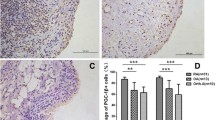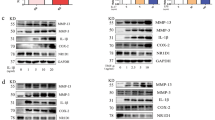Abstract
Objectives
Liver X receptors (LXR) are nuclear receptors that play important roles in lipid metabolism and transport. LXR also suppress inflammatory responses in macrophages through a unique mechanism of transrepression. This study was performed to investigate whether the synthetic LXR agonist GW3965 can modulate the inflammatory status of fibroblast-like synoviocytes (FLS) from patients with rheumatoid arthritis (RA) and to identify the mechanism for their effect.
Methods
RA FLS were treated with 0.1 and 1 μM of GW3965, a synthetic LXR agonist. The mRNA expressions of pro-inflammatory mediators were measured using quantitative real-time PCR. Apoptotic cell death of RA FLS was assessed using TUNEL assay and determination of caspase-3 activity by a colorimetric assay. The levels of transcriptional corepressors including NCoR and SMRT were determined using western blot analyses.
Results
Treatment of RA FLS with GW3965 induced dose-dependent reductions in mRNA expression of pro-inflammatory mediators (IL-1β, IL-6, MMP-9, CCL-2, CCL-7, and COX-2). However, treatment with GW3965 at the concentration selected for this study had no effect on apoptosis of RA FLS. Decreased productions of NCoR and SMRT by LPS stimulation was attenuated by GW3965 treatment.
Conclusions
GW3965 treatment suppressed mRNA expressions of pro-inflammatory mediators from RA FLS and inhibited the clearance of transcriptional corepressors. These data suggest that LXR activation can be used as a therapeutic approach to reduce the synovial inflammation in RA.






Similar content being viewed by others
References
Repa JJ, Mangelsdorf DJ. The role of orphan nuclear receptors in the regulation of cholesterol homeostasis. Annu Rev Cell Dev Biol. 2000;16:459–81.
Joseph SB, Castrillo A, Laffitte BA, Mangelsdorf DJ, Tontonoz P. Reciprocal regulation of inflammation and lipid metabolism by liver X receptors. Nat Med. 2003;9:213–9.
Morales JR, Ballesteros I, Deniz JM, Hurtado O, Vivancos J, Nombela F, et al. Activation of Liver X Receptors promotes neuroprotection and reduces brain inflammation in experimental stroke. Circulation. 2008;118:1450–9.
Terasaka N, Hiroshima A, Ariga A, Honzumi S, Koieyama T, Inaba T, et al. Liver X receptor agonists inhibit tissue factor expression in macrophages. FEBS J. 2005;272:1546–56.
Scholz H, Lund T, Dahle MK, Collins JL, Korsgren O, Wang JE, et al. The synthetic liver X receptor agonist GW3965 reduces tissue factor production and inflammatory responses in human islets in vitro. Diabetologia. 2009;52:1352–62.
Castrillo A, Joseph SB, Marathe C, Mangelsdorf DJ, Tontonoz P. Liver X receptor-dependent repression of matrix metalloproteinase-9 expression in macrophages. J Biol Chem. 2003;278:10443–9.
Wang YY, Dahle MK, Agren J, Myhre AE, Reinholt FP, Foster SJ, et al. Activation of the liver X receptor protects against hepatic injury in endotoxemia by suppressing Kupffer cell activation. Shock. 2006;25:141–6.
Ghisletti S, Huang W, Ogawa S, et al. Parallel SUMOylation-dependent pathways mediate gene- and signal-specific transrepression by LXRs and PPARgamma. Mol Cell. 2007;25:57–70.
Ghisletti S, Huang W, Jepsen K, Benner C, Hardiman G, Rosenfeld MG, et al. Cooperative NCoR/SMRT interactions establish a corepressor-based strategy for integration of inflammatory and anti-inflammatory signaling pathways. Genes Dev. 2009;23:681–93.
Venteclef N, Jakobsson T, Ehrlund A, Damdimopoulos A, Mikkonen L, Ellis E, et al. GPS2-dependent corepressor/SUMO pathways govern anti-inflammatory actions of LRH-1 and LXRbeta in the hepatic acute phase response. Genes Dev. 2010;24:381–95.
Haringman JJ, Smeets TJ, Reinders-Blankert P, Tak PP. Chemokine and chemokine receptor expression in paired peripheral blood mononuclear cells and synovial tissue of patients with rheumatoid arthritis, osteoarthritis, and reactive arthritis. Ann Rheum Dis. 2006;65:294–300.
Iwamoto T, Okamoto H, Toyama Y, Momohara S. Molecular aspects of rheumatoid arthritis: chemokines in the joints of patients. FEBS J. 2008;275:4448–55.
Boissier MC. Cell and cytokine imbalances in rheumatoid synovitis. Joint Bone Spine. 2011;78:230–4.
Chintalacharuvu SR, Sandusky GE, Burris TP, Burmer GC, Nagpal S. Liver X receptor is a therapeutic target in collagen-induced arthritis. Arthritis Rheum. 2007;56:1365–7.
Park MC, Kwon YJ, Chung SJ, Park YB, Lee SK. Liver X receptor agonist prevents the evolution of collagen-induced arthritis in mice. Rheumatology. 2010;49:882–90.
Asquith DL, Miller AM, Hueber AJ, McKinnon HJ, Sattar N, Graham GJ, et al. Liver X receptor agonism promotes articular inflammation in murine collagen-induced arthritis. Arthritis Rheum. 2009;60:2655–65.
Arnett FC, Edworthy SM, Bloch DA, McShane DJ, Fries JF, Cooper NS, et al. The American Rheumatism Association 1987 revised criteria for the classification of rheumatoid arthritis. Arthritis Rheum. 1988;31:315–24.
Collins JL, Fivush AM, Watson MA, Galardi CM, Lewis MC, Moore LB, et al. Identification of a nonsteroidal liver X receptor agonist through parallel array synthesis of tertiary amines. J Med Chem. 2002;45:1963–6.
Myhre AE, Agren J, Dahle MK, Tamburstuen MV, Lyngstadaas SP, Collins AJ, et al. Liver X receptor is a key regulator of cytokine release in human monocytes. Shock. 2008;29:468–74.
Choe SS, Choi AH, Lee JW, Kim KH, Chung JJ, Park J, et al. Chronic activation of liver X receptor induces beta-cell apoptosis through hyperactivation of lipogenesis: liver X receptor-mediated lipotoxicity in pancreatic beta-cells. Diabetes. 2007;56:1534–43.
Meng ZX, Nie J, Ling JJ, Sun JX, Zhu YX, Gao L, et al. Activation of liver X receptors inhibits pancreatic islet beta cell proliferation through cell cycle arrest. Diabetologia. 2009;52:125–35.
Murphy AJ, Akhtari M, Tolani S, Pagler T, Bijl N, Kuo CL, et al. ApoE regulates hematopoietic stem cell proliferation, monocytosis, and monocyte accumulation in atherosclerotic lesions in mice. J Clin Invest. 2011;121:4138–49.
Pascual-García M, Carbó JM, León T, Matalonga J, Out R, Van Berkel T, et al. Liver X receptors inhibit macrophage proliferation through downregulation of cyclins D1 and B1 and cyclin-dependent kinases 2 and 4. J Immunol. 2011;186:4656–67.
Kim KH, Lee GY, Kim JI, Ham M. Won Lee J, Kim JB. Inhibitory effect of LXR activation on cell proliferation and cell cycle progression through lipogenic activity. J Lipid Res. 2010;51:3425–33.
Pommier AJ, Alves G, Viennois E, Bernard S, Communal Y, Sion B, et al. Liver X Receptor activation downregulates AKT survival signaling in lipid rafts and induces apoptosis of prostate cancer cells. Oncogene. 2010;29:2712–23.
Wachsmann D, Sibilia J. Survival in the rheumatoid synovium. Joint Bone Spine. 2011;78:435–7.
Huber LC, Distler O, Tarner I, Gay RE, Gay S, Pap T. Synovial fibroblasts: key players in rheumatoid arthritis. Rheumatology. 2006;45:669–75.
Repa JJ, Liang G, Ou J, Bashmakov Y, Lobaccaro JM, Shimomura I, et al. Regulation of mouse sterol regulatory element-binding protein-1c gene (SREBP-1c) by oxysterol receptors, LXRalpha and LXRbeta. Genes Dev. 2000;14:2819–30.
Joseph SB, Laffitte BA, Patel PH, Watson MA, Matsukuma KE, Walczak R, et al. Direct and indirect mechanisms for regulation of fatty acid synthase gene expression by liver X receptors. J Biol Chem. 2002;277:11019–25.
Ogawa S, Lozach J, Jepsen K, Sawka-Verhelle D, Perissi V, Sasik R, et al. A nuclear receptor corepressor transcriptional checkpoint controlling activator protein 1-dependent gene networks required for macrophage activation. Proc Natl Acad Sci USA. 2004;101:14461–6.
Huang W, Ghisletti S, Saijo K, Gandhi M, Aouadi M, Tesz GJ, et al. Coronin 2A mediates actin-dependent de-repression of inflammatory response genes. Nature. 2011;470:414–8.
Morel J, Berenbaum F. Signal transduction pathways: new targets for treating rheumatoid arthritis. Joint Bone Spine. 2004;71:503–10.
Benito MJ, Murphy E, Murphy EP, Van den Berg WB, FitzGerald O, Bresnihan B. Increased synovial tissue NF-κB1 expression at sites adjacent to the cartilage-pannus junction in rheumatoid arthritis. Arthritis Rheum. 2004;50:1781–7.
Shiozawa S, Tsumiyama K. Pathogenesis of rheumatoid arthritis and c-Fos/AP-1. Cell Cycle. 2009;8:1539–43.
Schroen DJ, Chen JD, Vincenti MP, Brinckerhoff CE. The nuclear receptor corepressor SMRT inhibits interstitial collagenase (MMP-1) transcription through an HRE-independent mechanism. Biochem Biophys Res Commun. 1997;237:52–8.
Acknowledgements
This study was supported by a grant from the Korean Health Technology R&D Project, Ministry for Health, Welfare & Family Affairs, Republic of Korea (A100134) and a grant from the Yonsei University Research Fund [6-2010-0124].
We are grateful to Tae-Yeon Kim and Eunji Lee, Gangnam Severance Hospital Biomedical Research Center, for technical assistance, and to J. L. Collins, PhD, GlaxoSmithKline R&D, USA, for providing the GW3965 compound. GlaxoSmithKline had no role in study design, data collection, data analysis, data interpretation or manuscript preparation.
Conflict of Interest
The authors declare that they have no conflict of interest.
Author information
Authors and Affiliations
Corresponding author
Rights and permissions
About this article
Cite this article
Yoon, CH., Kwon, YJ., Lee, SW. et al. Activation of Liver X Receptors Suppresses Inflammatory Gene Expressions and Transcriptional Corepressor Clearance in Rheumatoid Arthritis Fibroblast Like Synoviocytes. J Clin Immunol 33, 190–199 (2013). https://doi.org/10.1007/s10875-012-9799-4
Received:
Accepted:
Published:
Issue Date:
DOI: https://doi.org/10.1007/s10875-012-9799-4




